Others
World Wetlands Day (February 02)
India Dominates South Asia on World Wetlands Day with 80 Ramsar Sites Spanning 1.33 Million Hectares
Posted On:
01 FEB 2024 6:35PM
“Wetlands are very important for the existence of our earth, because many birds and animals depend on them. Along with enriching Biodiversity, they also ensure flood control and groundwater recharge.”
About Wetlands
Wetlands are crucial ecosystems, disappearing rapidly due to human activities such as drainage, pollution, and overexploitation. This loss has profound implications for biodiversity, climate, and economies worldwide. To address this, there's a need to change perceptions and prioritize wetland conservation. Raising awareness, particularly on World Wetlands Day, is essential to catalyze action and safeguard these vital ecosystems.
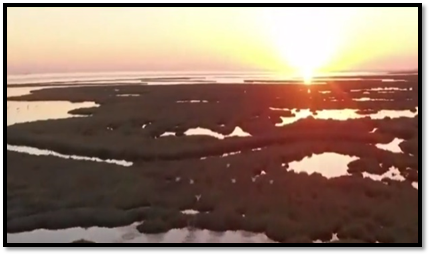
World Wetlands Day
World Wetlands Day, observed annually on February 2nd, raises awareness about wetlands and commemorates the adoption of the Convention on Wetlands in 1971. This international treaty provides a framework for wetland conservation and wise use. The significance of World Wetlands Day was emphasized in 2022 with the adoption of Resolution 75/317 by the UN General Assembly, establishing it as a global observance.
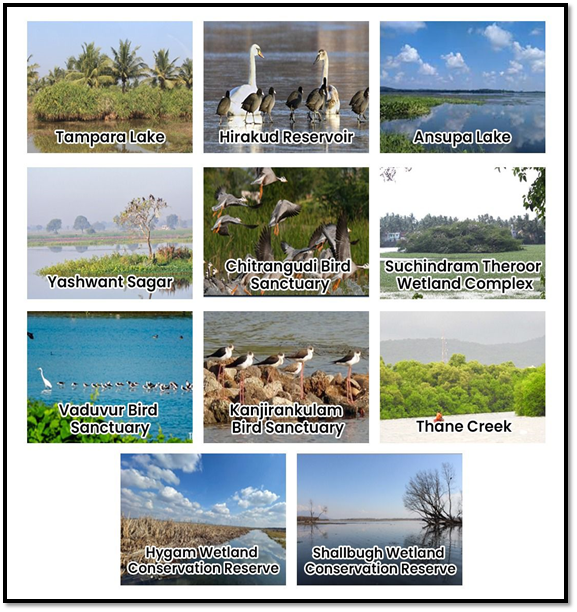
World Wetlands Day 2024
World Wetlands Day 2024 focuses on the theme 'Wetlands and Human Wellbeing,' highlighting the critical role wetlands play in enhancing our lives by providing flood protection, clean water, biodiversity, and recreational opportunities essential for human health and prosperity. This year, the Ministry of Environment, Forest & Climate Change (MoEF&CC), Government of India, in collaboration with the Government of Madhya Pradesh, is organizing the national World Wetlands Day event at Sirpur Lake, Indore, a Ramsar site designated in 2022. Dr. Musonda Mumba, Secretary-General of the Ramsar Convention, is visiting India to participate in the WWD 2024 event at Sirpur Ramsar site in Indore on February 2nd, 2024.
Wetlands in India – An Introduction
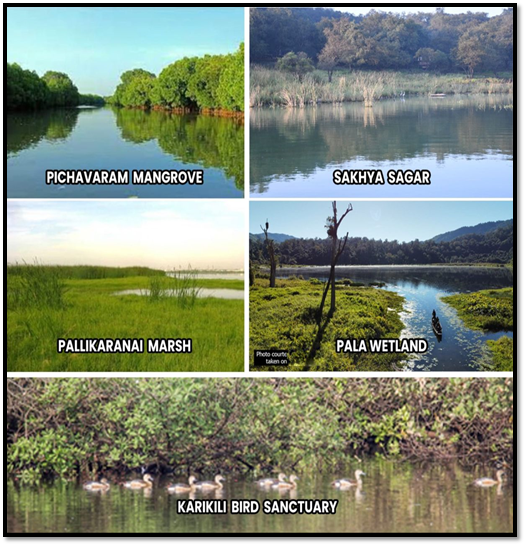
Wetlands hold significant cultural and traditional importance in India, with revered sites like Loktak Lake and Khecheopalri Lake. The country's diverse wetlands attract tourists and find mention in ancient texts like Chanakya's Arthashastra. India has made strides in wetland conservation, boasting the largest network of Ramsar Sites in South Asia, covering 1.33 million hectares. These sites contribute significantly to biodiversity, hosting 6200 species across various faunal groups. India's wetlands serve as crucial stopovers for millions of migratory birds, playing a vital role in maintaining waterbird populations globally. Despite global threats, India is reversing the trend of shrinking wetlands through legal protections and conservation efforts.
India's commitment to wetland conservation continues to strengthen with recent milestones marking significant progress. In January 2024, India proudly expanded its Ramsar Site count to 80 by designating five new sites in Karnataka and Tamil Nadu, showcasing its dedication to preserving invaluable ecosystems.
This achievement builds upon the momentum set in August 2022 when India added 11 wetlands to its roster, a poignant gesture commemorating the nation's 75th year of Independence. Additionally, the Wetlands of India Portal serves as a knowledge hub for wetland managers and stakeholders, providing comprehensive information and resources.
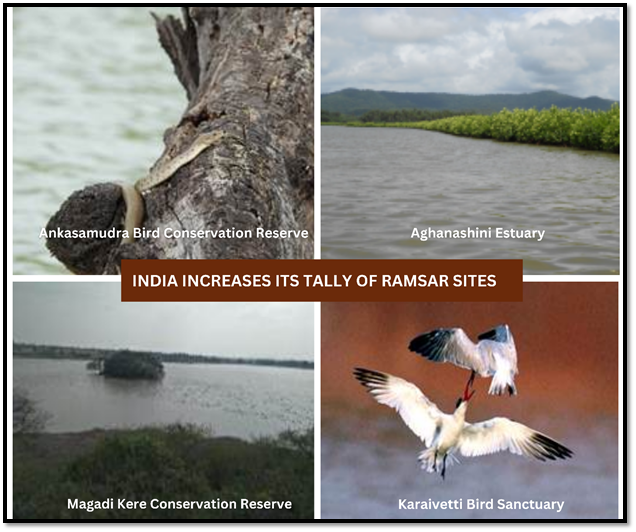
These efforts underscore India's commitment to conserving and managing its wetlands, vital ecosystems essential for biodiversity, climate resilience, and human well-being.
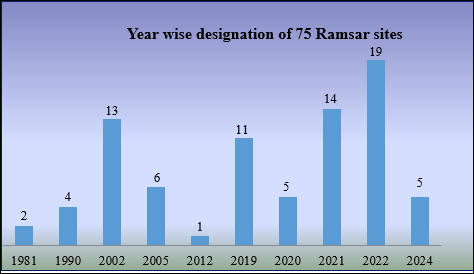
Source
Recent Developments
- Recognition of New Ramsar Sites: As of January 31, 2024, India proudly boasts a total of 80 Ramsar Wetlands, solidifying its position as the country with the highest number of wetlands in South Asia. This achievement was bolstered by the addition of five new sites, including the Karaivetti Bird Sanctuary and Longwood Shola Reserve Forest in Tamil Nadu, along with the Magadi Kere Conservation Reserve, Ankasamudra Bird Conservation Reserve, and Aghanashini Estuary in Karnataka. These designations signify India's unwavering commitment to preserving its invaluable wetland ecosystems.
· Earlier, on August 14, 2021, India celebrated the recognition of four additional wetlands as Ramsar sites by the Ramsar Secretariat. Notably, Haryana gained two new Ramsar sites, while Gujarat expanded its count by three, following the initial designation of Nalsarovar in 2012.
- Thol Lake Wildlife Sanctuary: Located in Gujarat and situated on the Central Asian Flyway, Thol Lake Wildlife Sanctuary is home to a diverse array of bird species, with over 320 species recorded within its boundaries. Notably, the sanctuary provides crucial habitat for more than 30 threatened waterbird species, including the critically endangered White-rumped Vulture and Sociable Lapwing, as well as the vulnerable Sarus Crane, Common Pochard, and Lesser White-fronted Goose.
- Wadhvana Wetland: Also located in Gujarat, the Wadhvana Wetland serves as a vital wintering ground for migratory waterbirds, hosting over 80 species that traverse the Central Asian Flyway. Among these avian visitors are several threatened or near-threatened species, including the endangered Pallas’s Fish-Eagle and vulnerable Common Pochard, along with the near-threatened Dalmatian Pelican, Grey-headed Fish-eagle, and Ferruginous Duck.
- National Wetland Decadal Change Atlas: The National Wetland Decadal Change Atlas, crafted by the Space Applications Centre (SAC) in Ahmedabad, offers valuable insights into the dynamic changes occurring in wetlands across the country over the past decade. This comprehensive resource serves as a vital tool for policymakers, researchers, and conservationists in understanding and addressing the evolving challenges faced by these critical ecosystems.
These recent developments underscore India's proactive efforts in wetland conservation, reaffirming its role as a global leader in safeguarding these ecologically significant habitats for present and future generations.
Government’s Initiatives for Wetland Conservation:
- Amrit Dharohar Scheme: Launched during the presentation of the Union Budget 2023-24, the Amrit Dharohar Scheme represents a pivotal step towards promoting optimal utilization of wetlands over the next three years. This initiative aims to enhance biodiversity, carbon stock, eco-tourism opportunities, and local community income generation, aligning with the government's vision for sustainable development.
- National Plan for Conservation of Aquatic Ecosystems: In 2013, the National Wetlands Conservation Programme merged with the National Lake Conservation Plan, giving rise to the comprehensive National Plan for Conservation of Aquatic Ecosystems. This amalgamation reflects the government's holistic approach towards safeguarding these vital ecosystems.
- Wetlands (Conservation and Management) Rules: Enacted in 2017 under the Environment (Protection) Act, 1986, the Wetlands (Conservation and Management) Rules established state wetlands authorities. These rules serve as a pivotal legal framework for the protection and sustainable management of wetlands across the nation.
- Coastal Protection: Coastal wetlands are safeguarded under the Coastal Regulation Zone Notification (2018) and the Island Protection Zone Notification 2011. These regulations ensure the preservation of coastal ecosystems, vital for biodiversity conservation and mitigating the impacts of climate change.
- MoEFCC's Wetlands Rejuvenation Programme: Initiated in 2020, the Ministry of Environment, Forest & Climate Change (MoEFCC) embarked on a transformative journey towards wetlands rejuvenation. This program employs a multifaceted approach encompassing baseline information development, rapid assessment through wetland health cards, establishment of stakeholder platforms, and comprehensive management planning. With over 500 wetlands covered, this initiative stands as a testament to the government's commitment to conserving these critical habitats.
- Integration with Namami Gange: On World Wetlands Day 2021, the Ministry of Jal Shakti underscored the integration of wetland conservation with the Namami Gange program. Through innovative efforts linked to river rejuvenation, the National Mission for Clean Ganga (NMCG) has spearheaded initiatives serving as a model for wetland conservation nationwide. The development of health cards and management plans for 10 wetlands in each of the 50-plus Ganga districts exemplifies this integrated approach, blending scientific expertise with community participation.
- National Wildlife Action Plan: India's National Wildlife Action Plan (2017-2031) prioritizes the conservation of inland aquatic ecosystems, including wetlands. It advocates for a national wetlands mission, emphasizing the importance of preserving these habitats for biodiversity conservation and ecosystem services.
These concerted efforts underscore the government's proactive stance towards wetland conservation, reflecting a commitment to sustainable development and environmental stewardship.
Conclusion
In conclusion, wetlands play a vital role in mitigating the impacts of natural disasters such as floods, droughts, and cyclones by acting as natural buffers and storing excess water. Events like the floods in Kashmir Valley and Chennai, as well as cyclones like Kalinga, underscore the importance of preserving wetlands for community resilience. Integrating wetlands into disaster risk reduction planning requires collaborative efforts, with assessments of wetland health incorporated into district-level planning processes. Conservation and restoration of wetlands should be prioritized within disaster risk reduction strategies, alongside efforts to raise awareness among stakeholders. The Government of India's commitment to wetlands conservation and mainstreaming their values into developmental planning demonstrates a crucial step towards ensuring the sustainable management of these invaluable ecosystems for future generations.
|
State wise list of Wetlands identified as Ramsar Sites in India (80)
|
| |
|
|
|
|
S.No
|
States
|
No of Ramsar Sites
|
Name of Ramsar Site
|
|
1
|
Andhra Pradesh
|
1
|
Kolleru Lake
|
|
2
|
Assam
|
1
|
Deepor Beel
|
|
3
|
Bihar
|
1
|
Kabartal Wetland
|
|
4
|
Goa
|
1
|
Nanda Lake
|
|
5
|
Gujarat
|
4
|
Khijadia Wildlife Sanctuary
|
|
Nalsarovar Bird Sanctuary
|
|
Thol Lake Wildlife Sanctuary
|
|
Wadhvana Wetland
|
|
6
|
Haryana
|
2
|
Bhindawas Wildlife Sanctuary
|
|
Sultanpur National Park
|
|
7
|
Himachal Pradesh
|
3
|
Chandertal Wetland
|
|
Pong Dam Lake
|
|
Renuka Wetland
|
|
8
|
Jammu & Kashmir
|
6
|
Wular Lake
|
|
Hokera Wetland
|
|
Surinsar-Mansar Lakes
|
|
Tsomoriri Lake
|
|
Hygam Wetland Conservation Reserve
|
|
Shallbugh Wetland Conservation Reserve
|
|
9
|
Karnataka
|
4
|
Ranganathituu BS
|
|
Ankasamudra Bird Conservation Reserve
|
|
Aghanashini Estuary
|
|
Magadi Kere Conservation Reserve
|
|
10
|
Kerala
|
3
|
Asthamudi Wetland
|
|
Sasthamkotta Lake
|
|
VembanadKol Wetland
|
|
11
|
Ladakh
|
1
|
Tso Kar Wetland Complex
|
|
12
|
Madhya Pradesh
|
4
|
Bhoj Wetlands
|
|
Sakhya Sagar
|
|
Sirpur wetland
|
|
Yashwant Sagar
|
|
13
|
Maharashtra
|
3
|
Lonar Lake
|
|
Nandur Madhameshwar
|
|
Thane Creek
|
|
14
|
Manipur
|
1
|
Loktak Lake
|
|
15
|
Mizoram
|
1
|
Pala wetland
|
|
16
|
Orissa
|
6
|
Bhitarkanika Mangroves
|
|
Chilka Lake
|
|
Satkosia Gorge
|
|
Tampara Lake
|
|
Hirakud Reservoir
|
|
Ansupa Lake
|
|
17
|
Punjab
|
6
|
Beas Conservation Reserve
|
|
Harike Lake
|
|
Kanjli Lake
|
|
Keshopur-Miani Community Reserve
|
|
Nangal Wildlife Sanctuary
|
|
Ropar Lake
|
|
18
|
Rajasthan
|
2
|
Keoladeo Ghana NP
|
|
Sambhar Lake
|
|
19
|
Tamil Nadu
|
16
|
Point Calimere Wildlife and Bird Sanctuary
|
|
Karikili Bird Sanctuary
|
|
Pallikaranai Marsh Reserve Forest
|
|
Pichavaram Mangrove
|
|
Koonthankulam Bird Sanctuary
|
|
Gulf of Mannar Marine Biosphere Reserve
|
|
Vembannur Wetland Complex
|
|
Vellode Bird Sanctuary
|
|
Vedanthangal Bird Sanctuary
|
|
Udhayamarthandapuram Bird Sanctuary
|
|
Chitrangudi Bird Sanctuary
|
|
SuchindramTheroor Wetland Complex
|
|
Vaduvur Bird Sanctuary
|
|
Kanjirankulam Bird Sanctuary
|
|
Karaivetti Bird sanctuary
|
|
Longwood Shola Reserve Forest
|
|
20
|
Tripura
|
1
|
Rudrasagar Lake
|
|
21
|
Uttar Pradesh
|
10
|
Bakhira Wildlife Sanctuary
|
|
Haiderpur Wetland
|
|
Nawabganj Bird Sanctuary
|
|
Parvati Agra Bird Sanctuary
|
|
Saman Bird Sanctuary
|
|
Samaspur Bird Sanctuary
|
|
Sandi Bird Sanctuary
|
|
SarsaiNawarJheel
|
|
Sur Sarovar
|
|
Upper Ganga River
(Brijghat to Narora Stretch)
|
|
22
|
Uttarakhand
|
1
|
Asan Conservation Reserve
|
|
23
|
West Bengal
|
2
|
East Kolkata Wetlands
|
|
Sunderbans Wetland
|
Video links
· https://www.youtube.com/watch?v=3P9OoWuTBdY
Twitter links
· https://twitter.com/narendramodi/status/1619647149154897920?s=20&t=mMb4tjd4ZDMWlh1Al-rM93SldlyivXuPRweEoWxyZtQ
· https://twitter.com/byadavbjp/status/1426232561341108225
· https://twitter.com/byadavbjp/status/1558291121893441536?s=20&t=_BiBo-X512iEvEPNqY8toA
· https://twitter.com/moefcc/status/1551882643167330309?s=20&t=7LNwylqjEFXiZGWNxBaSvg
· https://twitter.com/byadavbjp/status/1551812254315585537?s=20&t=7LNwylqjEFXiZGWNxBaSvg
· https://twitter.com/PrakashJavdekar/status/1327928897665519616
· https://twitter.com/byadavbjp/status/1468954855846789124
References
· https://nmcg.nic.in/writereaddata/fileupload/40_Urban%20Wetlandwater%20bodiesmanagement%20guidelines.pdf
· Why India values wetland conservation by Union Minister of MoEFCC, Hindustan Times, dated February 05, 2022
· https://static.pib.gov.in/WriteReadData/userfiles/Faunal_Diversity_of_Ramsar_Wetlands_of_India_E_verion_02.02.2021.pdf
· https://www.un.org/en/observances/world-wetlands-day
· https://www.epa.gov/wetlands/what-wetland
· https://www.ramsar.org/sites/default/files/flipbooks/ramsar_gwo_english_web.pdf
· https://www.un.org/en/observances/world-wetlands-day
· http://www.wiienvis.nic.in/Database/ramsar_wetland_sites_8224.aspx
· PIB Press Release on India establishes Asia’s largest Ramsar Sites network in the 75th Year of Independence dated December 23, 2022.
· PIB Press Release on 75 Ramsar Sites in 75th Year of Independence dated August 13, 2022.
· PIB Press Release on India adds 10 more wetlands designated as Ramsar sites to make total 64 sites dated August 3, 2022.
· PIB Press Release on India Designates 5 New Ramsar Sites dated July 26, 2022.
· PIB Press Release on NamamiGange first program in India to link Wetland Conservation to Basin Management Plan dated February 02, 2021.
· PIB Press Release on Ladakh’s Tso Kar Wetland Complex now a Wetland of International Importance dated December 24, 2020.
· PIB Press Release on ‘Wetlands of India’ Portal, a single point access to all information relating to wetlands dated October 02, 2021.
· PIB Press Release on On World Wetlands Day India gets its first Centre for Wetland Conservation and Management dated February 02, 2021.
· PIB Press Release on 10 more wetlands from India get the Ramsar site tag dated January 28, 2020.
***
NR/HP/RK/MI/JA
(Explainer ID: 151805)
आगंतुक पटल : 6594
Provide suggestions / comments